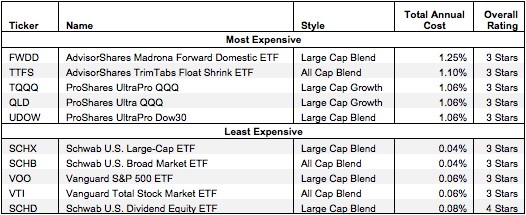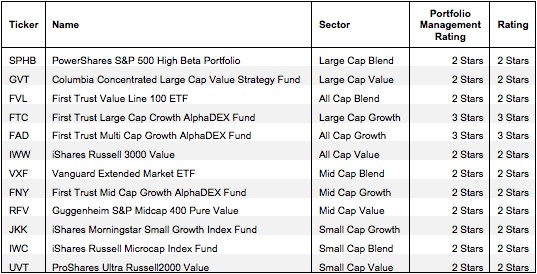Picking from the multitude of style ETFs is a daunting task. There are as many as 40 in any given style and at least 221 ETFs across all styles.
Why are there so many ETFs? The answer is: because ETF providers are making lots of money selling them. The number of ETFs has little to do with serving investors’ best interests. Below are three red flags investors can use to avoid the worst ETFs:
- Inadequate liquidity
- High fees
- Poor quality holdings
I address these red flags in order of difficulty to overcome. Advice on How to Find the Best Style ETFs is here.
How To Avoid ETFs with Inadequate Liquidity
This is the easiest issue to avoid and my advice is simple: Avoid all ETFs with less than $100 million in assets. Low levels of liquidity can lead to a discrepancy between the price of the ETF and the underlying value of the securities it holds. In addition, low asset levels tend to mean lower volume in the ETF and large bid-ask spreads.
How To Avoid High Fees
ETFs should be cheap, but not all of them are. The first step here is to measure what is cheap and expensive.
To ensure you are paying at or below average fees, invest only in ETFs with an expense ratio below 0.44%, which is the average total annual cost (TAC) of the 221 US equity style ETFs I cover. Weighting the TAC by assets under management, the average expense ratio is lower at 0.19%. The lower weighted-average TAC is a good sign that investors are putting money in the cheaper ETFs.
Figure 1 shows the most and least expensive style ETFs in the US equity universe based on total annual costs. ProShares provides three of the five most expensive style ETFs, as well as four of the five of the most expensive sector ETFs covered earlier. More on general sector ETF costs is here.
Figure 1: Most & Least Expensive ETFs (as of 5/23/13)
AdvisorShares Madrona Forward Domestic ETF (FWDD) and AdvisorShares TrimTabs Float Shrink ETF (TTFS) are the two most expensive US equity style ETFs I cover. Schwab U.S. Large-Cap ETF (SCHX) and Schwab U.S. Broad Market ETF (SCHB) are the two least expensive. In addition to being one of the five least expensive, Vanguard Total Stock Market ETF (VTI) ranks well among style ETFs in general and has over $31 billion in assets, the most of any fund in Figure 1. Schwab U.S. Dividend Equity ETF (SCHD) is my top-rated style ETF overall in while also being the fifth least expensive.
Interestingly, ProShares UltraPro Dow30 (UDOW), ProShares Ultra QQQ (QLD), and ProShares UltraPro QQQ (TQQQ) are the next three highest rated ETFs in Figure 1, ranking in the low 20’s among all the style ETFs I cover overall despite being among the five most expensive ETFs.
These observations underscore why investors should not choose ETFs based only on price. The quality of holdings matters more than price in making an ETF attractive for investors.
How To Avoid ETFs with the Worst Holdings
This step is by far the hardest, but it is also the most important because an ETF’s performance is determined more by its holdings than its costs. Figure 2 shows the ETFs within each style with the worst holdings or portfolio management ratings. The ETFs are listed in descending order by style per my style ratings, detailed in my 2Q Style Rankings report.
Figure 2: Style ETFs With Worst Holdings (as of 5/23/13)
My overall ratings on ETFs are based primarily on my stock ratings of their holdings. My firm covers over 3000 stocks and is known for the due diligence done on each stock we cover.
First Trust’s ETFs appear more often than any other provider in Figure 2, which means they offer the most ETFs with the worst holdings. The worst-rated ETFs in the All Cap Blend, Large Cap Growth, All Cap Growth, and Mid Cap Growth categories all belong to First Trust: First Trust Value Line 100 ETF (FVL), First Trust Large Cap Growth AlphaDEX Fund (FTC), First Trust Multi Cap Growth AlphaDEX Fund (FAD), and First Trust Mid Cap Growth AlphaDEX Fund (FNY).
Do Not Trust ETF Labels
Many ETFs are labeled “index” ETFs. Naturally, many investors might assume that having “index” in the ETF’s name means all the holdings are the same or the provider cannot influence the nature of the holdings, but that is not true.
For example, of the three “index” ETFs in the mid-cap growth style, two get a Neutral rating while one gets a Dangerous rating. How is that possible if they are supposed to hold the same stocks? The answer is that they do not hold the same stocks.
There is no overlap in the top 5 holdings among these three ETFs. Their portfolios are not close to being the same. And there is a meaningful difference in the quality of holdings.
iShares S&P MidCap 400 Growth Index Fund (IJK) gets 2-star or a Dangerous rating because it has more dangerous-rated holdings. iShares Morningstar Mid Growth Index Fund (JKH) and iShares Russell Midcap Growth Index (IWP) get 3-stars and have more neutral-rated holdings.
Hence, the “index” label, for mid-cap growth ETFs, is misleading as it does not mean that these ETFs have the same portfolio of holdings. For more on how the index label is misleading, see “Danger Zone 12/31/2012: iShares S&P MidCap 400 Growth Index Fund (IJK)”.
The point is that investors cannot trust the “index” label to mean that all the ETFs or mutual funds with that label hold a standard portfolio of stocks.
The Danger Within
Buying an ETF without analyzing its holdings is like buying a stock without analyzing its business and finances. As Barron’s says, investors should know the Danger Within. Put another way, research on ETF holdings is necessary due diligence because an ETF’s performance is only as good as its holdings’ performance.
PERFORMANCE OF ETF’s HOLDINGs = PERFORMANCE OF ETF
Note that no ETFs with a dangerous portfolio management rating earn an overall rating better than two stars. These scores are consistent with my belief that the quality of an ETF is more about its holdings than its costs. If the ETF’s holdings are dangerous, then the overall rating cannot be better than dangerous because one cannot expect the performance of the ETF to be any better than the performance of its holdings – no matter how cheap it may be.
Find the ETFs with the worst overall ratings on my ETF screener. More analysis of the Best Style ETFs is here.
Best & Worst Stocks In these ETFs
Advanced Micro Devices, Inc. (AMD) is one of my least favorite stocks in SPHB’s top five holdings and earns my Dangerous rating. There is much to dislike about AMD, starting with the fact that it has not posted positive economic earnings going back to 1998 when my model begins. Additionally, its return on invested capital (ROIC) of 2% puts it in the bottom quintile of all the companies I cover. Nevertheless, AMD is priced for significant growth by the market at ~$3.96/share. To justify this price, the company must grow after-tax profit (NOPAT) by 10% for the next 8 years. For a few companies, those profit growth expectations might be reasonable. However, with AMD’s shaky history and with NOPAT falling as much as 440% in some recent years, investors cannot rely on this firm for consistent growth and returns.
The Altria Group (MO) is one of my favorite stocks held by SCHD and earns my Very Attractive rating. The Altria Group earns my highest rating due in large part to its steadily rising NOPAT and economic earnings. Its ROIC is also in the top quintile of all the companies I cover. Topping off all of this, the current share price of ~$36.90 gives MO a price to economic book value ratio of 0.84, meaning that the market is anticipating a permanent 16% decline in Altria’s NOPAT. Altria is highly profitable and significantly undervalued, an ideal combination for investors. SCHD’s allocation to MO and other Attractive-or-better rated stocks, combined with its position in the top five cheapest ETFs make it an Attractive, (4-star) fund.
Sam McBride and André Rouillard contributed to this report.
Disclosure: David Trainer, Sam McBride and André Rouillard receive no compensation to write about any specific stock, sector, or theme.


2 replies to "How To Avoid the Worst Style ETFs"
Vanguard uses a nine-box grid called a style box to show how our domestic stock fund ETF holdings are distributed by primary investment style (growth, value, or blend) and market segment (large-, mid-, and small-cap companies).
Value style ETFs can be small, large, or mid-cap funds, but are created to track companies that are trading at a lower market price than their “true” value. Sometimes a stock may not be trading at its full potential if sector or market news is holding it down. This could be an example of a value stock. It comes down to a case of “true value” versus market opinion.